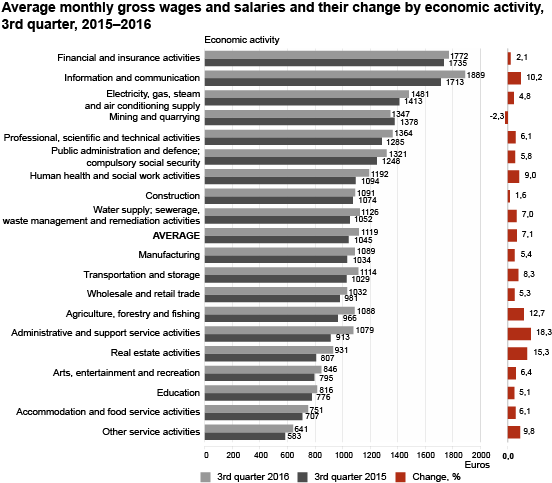In the 3rd quarter, the rise in average wages and salaries continued to decelerate
The average hourly gross wages and salaries were 6.62 euros in the 3rd quarter of 2016, having increased 5.4% compared to the 3rd quarter of 2015.
The average monthly gross wages and salaries were 1,126 euros in July, 1,101 euros in August and 1,129 euros in September. Compared to the previous quarter, the gross wages and salaries fell 3.8%, mainly due to a decrease in irregular bonuses and premiums and an increase in the number of paid-leave days. Without irregular bonuses and premiums, the average gross wages and salaries decreased 2.6% compared to the previous quarter.
Irregular bonuses and premiums decreased 38.6% per employee compared to the 2nd quarter of 2016 but increased 10.8% per employee compared to the 3rd quarter of 2015. Irregular bonuses and premiums affected the year-over-year increase in average gross monthly wages and salaries by 0.1 percentage points. Without irregular bonuses and premiums, the average monthly gross wages and salaries increased by 7.0% year over year in the 3rd quarter, with annual growth remaining on the same level as in the 1st quarter (7.2%) and in the 2nd quarter (7.3%).
Real wages, which take into account the influence of the change in the consumer price index, increased slower (6.7%) than the average monthly gross wages and salaries in the 3rd quarter of 2016 compared to the 3rd quarter of 2015 due to an increase in consumer prices. Compared to the same quarter of the previous year, real wages have been increasing since the second half of 2011.
The average monthly gross wages and salaries continued to be the highest in information and communication and in financial and insurance activities. Compared to the 3rd quarter of 2015, the average monthly gross wages and salaries increased in almost all economic activities (except mining and quarrying). The largest year-over-year increase of average monthly gross wages and salaries occurred in administrative and support service activities (18.3%) and in real estate activities (15.3%). Above-average growth in wages and salaries was also recorded in agriculture, forestry and fishing (12.7%), information and communication (10.2%) and in other service activities (9.8%).
The year-over-year growth of average monthly gross wages and salaries was the fastest in the Estonian private sector (8.6%). A faster than average rise in wages and salaries occurred also in local governments (7.7%), where the average monthly gross wages and salaries are the lowest. The slowest increase in monthly gross wages and salaries occurred in state institutions (3.9%).
In the 3rd quarter of 2016, by county, the average monthly gross wages and salaries were the highest in Harju (1,253 euros) and Tartu (1,105 euros) counties and the lowest in Põlva (808 euros), Jõgeva (843 euros) and Saare (852 euros) counties. The year-over-year growth of average monthly gross wages and salaries was the fastest in Tartu county (9.6%), while the average monthly gross wages and salaries decreased slightly in Hiiu and Rapla counties.According to the Wages and Salaries Statistics Survey, the number of employees converted to full-time units decreased by 1.8% compared to the 2nd quarter of 2016 and by 2.1% compared to the 3rd quarter of 2015. The biggest year-over-year decrease in the number of employees in full-time units occurred in real estate activities (12.2%), mining and quarrying (11.2%) and in financial and insurance activities (11.2%). The only economic activities having undergone a small increase in the number of employees over the course of a year include information and communication, human health and social work activities, and professional, scientific and technical activities.
In the 3rd quarter of 2016, the average monthly labour costs per employee were 1,508 euros and the hourly labour costs were 10.5 euros. Compared to the 3rd quarter of 2015, the average monthly labour costs per employee increased 7.1%.
| Period | Average labour costs | Average monthly gross wages and salaries | Average monthly net wages and salaries | |
|---|---|---|---|---|
| 2014 | I | 1305 | 966 | 769 |
| II | 1379 | 1023 | 812 | |
| III | 1319 | 977 | 777 | |
| IV | 1404 | 1039 | 827 | |
| 2015 | I | 1361 | 1010 | 815 |
| II | 1459 | 1082 | 871 | |
| III | 1408 | 1045 | 842 | |
| IV | 1492 | 1105 | 891 | |
| 2016 | I | 1476 | 1091 | 882 |
| II | 1568 | 1163 | 937 | |
| III | 1508 | 1119 | 902 | |
Statistics Estonia conducts the Wages and Salaries Statistics Survey on the basis of an international methodology since 1992. In 2016, the sample includes 12,350 enterprises, institutions and organisations. The average monthly gross wages and salaries have been given in full-time units to enable a comparison of different wages and salaries, irrespective of the length of working time. Calculations of the monthly gross wages and salaries are based on payments for time actually worked and remuneration for time not worked. The hourly gross wages and salaries do not include remuneration for time not worked (holiday leave pay, benefits, etc.). In short-term statistics, the average gross wages and salaries are measured as a component of labour costs. Labour costs include gross wages and salaries, employer’s contributions and employer’s imputed social contributions to employees.
The statistics are based on the questionnaire “Wages and salaries”, the deadline of which was 18 October 2016. Statistics Estonia published the quarterly summary in 26 working days. For the statistical activity “Wages and salaries”, the main representatives of public interest are the Ministry of Economic Affairs and Communications, commissioned by whom Statistics Estonia collects and analyses the data necessary for conducting the statistical activity.